Jules-Louis Audemars |
Edward-Auguste Piguet |
AP
AUDEMARS PIGUET
Master watchmakers
Jules-Louis Audemars |
Edward-Auguste Piguet |
| The history of AUDEMARS PIGUET begins in 1875, when Jules Audemars and Edward Piguet, two talented master watchmakers, joined forces to found a company in Le Brassus, which immediately specialized in ultra-thin watches with complications. Perhaps the most prominent line in the Audemars Piguet collection is the Royal Oak, which was launched in 1972. The name is rooted in English history: it is said that Charles II, when pursued by Cromwell's army in 1651, took refuge in the hollow trunk of an oak. Inspired by the story, the Royal Nayy between 1803 and 1914 christened three of its largest battleships "Royal Oak." Spurred by the rich historical heritage of the name, Audemars Piguet decided to commission a design from that rascal Gerald Genta that would be a worthy reflection of this proud heritage. The shape is derived from the shape of a porthole, with the bezel attached by eight hexagonal bolts made of white gold. Purists may note that the slots of the screws are, of course, always perfectly aligned to follow the curvature of the case. |
| Still, one of the watches that have been high on my list is the Royal Oak by Audemars Piguet. For me, it would be the simplest version, if cost were no object, in gold on leather strap or else just like the one here. It has everything you need: automatic with date, rugged yet elegant and definitely beautiful. What more can you ask for? The Royal Oak Offshore Chronograph (below are three models) is another favorite model of the big guy, Arnold Schwarzenegger. This watch is big, in fact, unless you have seen it, you will not believe how big it really is! I was certainly stunned when I first saw it: it takes one huge wrist and ego to put this on. Click on one of the pictures above to go to the Audemars Piguet web site! |
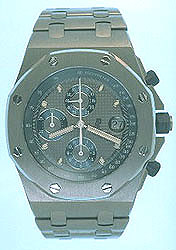 |
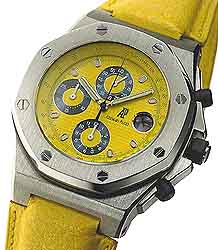 |
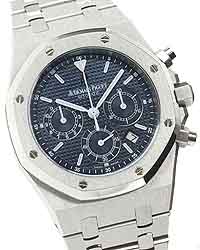 |
| If you like to complicate things,
the Royal Oak can deliver there as well. On the right is
probably my favorite RO complication, the day/date with
moonphase indicator. Below, you can see, from the left:
the Royal Oak tourbillon , the skeleton perpetual
calendar model with all the bells and whistles, and on the
right the Royal Oak with date and dual time zone. There
are two problems here, though: the more complicated your
Royal Oak, the bigger it seems to get (read: showy), and
price-wise, you may decide rather to visit an automobile
dealer and get that new Mercedes Benz with all the extras;
it might be cheaper. Approximately 25% of Audemars Piguet's annual production, which for 1997 was stated to be 15,000 units, are quartz watches. The "Royal Oak," which has gradually become the company's flagship, accounts for approximately 52% of the total output. In order to counteract a possible dissemination of its potential, a more aggressive business strategy will see the corporation concentrate on four collection families, i.e. on the Royal Oak, the Millenary, the complications, and ladies' jewellery watches. |
|
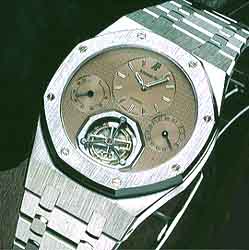 |
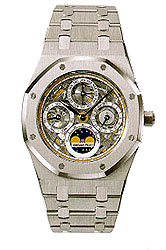 |
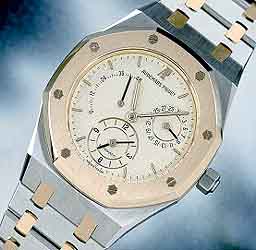 |
|
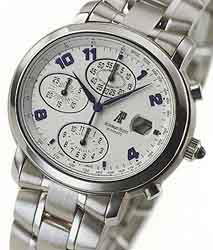 |
It remains to be seen how well the public will respond to the Millenary; significantly, Omega opted for a more conventional round shape when re-issuing the Dynamic auto and chrono. Ergonomically, the chronograph seems to suffer from the oval shape, while the automatic has no such problems. |  |
| The sales of Audemars Piguet watches have a certain geographical obliquity. Over half of the sales are made on the Asiatic market, particularly in Hong Kong, Japan, Taiwan and Singapore. The European proportion is in the range of 30 to 35%, lately showing some upsurge. A problem area seems to be the purchase-strong Americas with approximately a 10% share. The management of Audemars Piguet justifies this rather one-sided distribution structure mainly with the different utilization of the distribution and sales syndicates. |
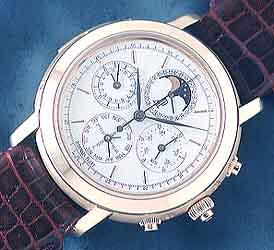 |
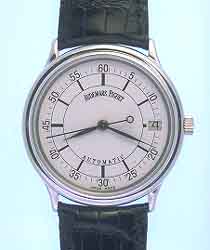 |
 |
| The present vast range of Audemars Piguet is illustrated by the three models above. The simple, slightly old-fashioned looking automatic in the middle is flanked by, on the left: an automatic "Grande Complication" with perpetual calendar showing day, date, month, leap years, moon phases and weeks, minute repeater and split-seconds chronograph (virtually all the functions that can be crammed into a wristwatch). On the right, an "undressed" complication, a skeletal perpetual calendar. Again, these skeleton watches are largely a matter of taste. While they show the watch maker's bravura to the fullest, they usually are lacking in one important function of every timepiece: it is frustratingly difficult to try to read the time. |
|
|
|
| Naturally, AUDEMARS PIGUET makes many more "elementary" models and in fact, some of their complications are among the most elegant and desirable watches on the market, watches that are less ostentatious in their complexity than the models above. Indeed, it is difficult to conceive of designs that are more unaffected than those of the automatic two-register chronograph on the left or the two versions of the "Grande Sonnerie," a minute repeater, beside it. To my mind, and I doubt that I would be alone in my assessment, they rival Patek Philippe in the distinguished appeal of their design. |
| Page 1: hello |
Page 2: nice things |
Page 3: Audemars Piguet |
Page 4: IWC, JLC |
Page 5: Patek Philippe |
| Page 6: Flieger |
Page 7: more Flieger |
Page 8: Zenith, Eberhard |
Page 9: chronographs |
Page 10: big money! |
| Page 11: mo' money |
Page 12: more chronos |
Page 13: less known gems |
Page 14: moonstruck |
Page 15: pictures & links |